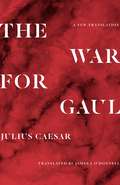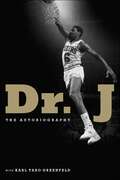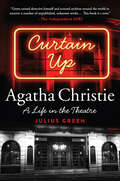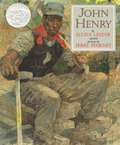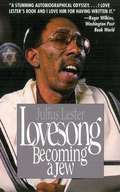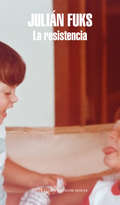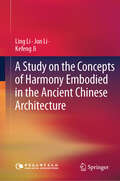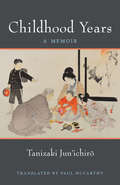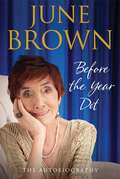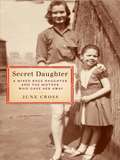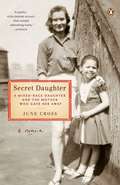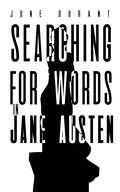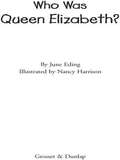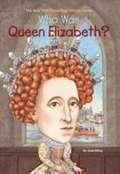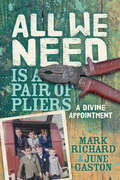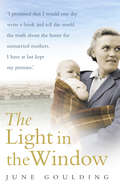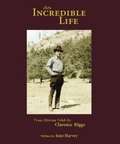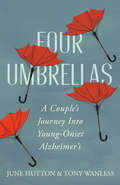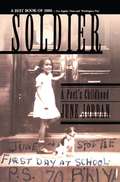- Table View
- List View
The War for Gaul: A New Translation
by Julius CaesarA new translation that captures the gripping power of one of the greatest war stories ever told—Julius Caesar’s pitiless account of his brutal campaign to conquer GaulImagine a book about an unnecessary war written by the ruthless general of an occupying army—a vivid and dramatic propaganda piece that forces the reader to identify with the conquerors and that is designed, like the war itself, to fuel the limitless political ambitions of the author. Could such a campaign autobiography ever be a great work of literature—perhaps even one of the greatest? It would be easy to think not, but such a book exists—and it helped transform Julius Caesar from a politician on the make into the Caesar of legend. <P><P>This remarkable new translation of Caesar’s famous but underappreciated War for Gaul captures, like never before in English, the gripping and powerfully concise style of the future emperor’s dispatches from the front lines in what are today France, Belgium, Germany, and Switzerland. <P><P>While letting Caesar tell his battle stories in his own way, distinguished classicist James O’Donnell also fills in the rest of the story in a substantial introduction and notes that together explain why Gaul is the “best bad man’s book ever written”—a great book in which a genuinely bad person offers a bald-faced, amoral description of just how bad he has been. <P><P>Complete with a chronology, a map of Gaul, suggestions for further reading, and an index, this feature-rich edition captures the forceful austerity of a troubling yet magnificent classic—a book that, as O’Donnell says, “gets war exactly right and morals exactly wrong.”
Dr. J: The Autobiography
by Karl Taro Greenfeld Julius Erving“A terrific memoir by a man worthy of one.” — Sports IllustratedAn honest, unflinching self-portrait of the basketball legend whose classy public image as a superstar and a gentleman masked his personal failings and painful losses, which he describes here—from his own point of view—for the very first time.For most of his life, Julius Erving has been two men in one. There is Julius, the bright, inquisitive son of a Long Island domestic worker who has always wanted to be respected for more than just his athletic ability, and there is Dr. J, the cool, acrobatic showman whose flamboyant dunks sent him to the Hall of Fame and turned the act of jamming a basketball through a hoop into an art form. In many ways, Erving’s life has been about the push and pull of Julius and The Doctor.It is Dr. J who has stories to tell of the wild days and nights of the ABA in the 1970s, and of being the seminal figure who transformed basketball from an earthbound and rigid game into the creative, free-flowing aerial display it is today. He has a long list of signature plays - he’s famous for winning the first dunk contest in 1976 with a jam on which he lifted off from the foul line, and he made a miraculous layup against the Lakers on which he soared behind the backboard before reaching back in to flip the ball in on the other side, with one hand. He inspired a generation of dunkers, including Michael Jordan, to express their improvisational talents.But Julius wasn’t always as graceful and in control as Dr. J. Erving had a pristine image throughout his career and early retirement, but he was far from a perfect man. Here he gives detailed accounts of some of the personal problems he faced -- or created -- behind the scenes, including the adulterous affair with sports writer Samantha Stephenson, which led to the birth of his daughter, professional tennis player Alexandra Stephenson.Though his marriage survived that infidelity, the death of Erving’s 20-year-old son Cory in 2000 in a tragic accident proved too much for the union to bear. Erving paints a raw, heartbreaking picture of the dissolution of his marriage, as his wife Turquoise began to blame him for his refusal to be paralyzed by grief for as long as she was. Their intense arguments came to a head when Erving stepped out of the shower one day to find his wife holding a lamp in one hand and a vase in the other, ready for a physical confrontation. “I knew somebody was going to get hurt, and it wasn’t going to be me,” he says. He packed a suitcase and he and Turquoise never lived under the same roof again.Erving’s story is a tale of the nearly perfect player and the imperfect man, and how he has come to terms with both of them. It will appeal to readers on a sports level and on a human one.
Curtain Up: Agatha Christie: A Life in the Theatre
by Julius Green“[Julius] Green turned detective himself and scoured archives around the world to uncover a number of unpublished, unknown works . . . This book is a treat.” —Independent (UK)From the producer of numerous Agatha Christie stage plays comes the first book to examine the world’s bestselling mystery writer’s career and work as a playwright, published to commemorate her 125th birthday.Agatha Christie has long been revered around the world for her mysteries and the indelible characters she created, Miss Jane Marple and Hercule Poirot. In addition to her contributions as a novelist, this gifted writer was also an acclaimed playwright. Offering a unique, in-depth look at her work for the stage, Curtain Up analyzes her plays and features excerpts from Agatha Christie’s correspondences, notebooks, and several unpublished and unperformed scripts quoted from for the first time.Meticulously researched, peppered with groundbreaking discoveries—including a detaile discussion of her only play to premiere in America—Curtain Up sheds new light on Christie’s artistry and adds a fascinating layer to her remarkable story.
John Henry
by Julius LesterJohn Henry is stronger than ten men, and can dig through a mountain faster than a steam drill. Julius Lester's folksy retelling of a popular African-American folk ballad has warmth, tall tale humor, and boundless energy. <P><P>Jerry Pinkney illustrates the story with "rich colors borrowed from the rocks and the earth, so beautiful that they summon their own share of smiles and tears" (Booklist).<P> <p><B>Caldecott Honors Book</B>
Lovesong: Becoming a Jew
by Julius LesterJulius Lester was born the son of a black Methodist minister in the south. His book Lovesong is a beautifully written account of his spiritual journey away from the conventions of his Southern heritage and Methodist upbringing, culminating in his personal self-discovery through a conversion to Judaism.Growing up in the turbulent civil rights era South, Lester was often discouraged by the disconnectedness between the promises of religion and the realities of his life. He used the outlets available to him to try to come to grips with this split and somehow reconcile the injustices he was witnessing with the purity of religion. He became a controversial writer and commentator, siding with neither blacks nor whites in his unconventional viewpoints. He became a luminal figure of the times, outside of the conventional labels of race, religion, politics, or philosophy.Lester's spiritual quest would take him through the existential landscape of his Southern, Christian upbringing, into his ancestry, winding through some of the holiest places on the planet and into the spiritual depths of the world's major religious cultures. His odyssey of faith would unexpectedly lead him to discovering Judaism as his true spiritual calling.
The Blues Singers: Ten Who Rocked the World
by Julius LesterThe blues. It's that low-down feeling that makes you ache from your soul to the soles of your shoes. Here in the voice of a grandfather passing on a legacy to a younger generation, renowned author Julius Lester introduces ten of the hottest black blues singers of our time. The diva Aretha Franklin, the legendary Billie Holiday, and the fabulous B.B. King are just a taste of what's in store.
Daniel Kish: A Different Way to See (Fountas & Pinnell Classroom, Guided Reading)
by Julius SmithersonNIMAC-sourced textbook. CHANGING IDEAS ABOUT BLIND PEOPLE. Daniel Kish is blind, but he learned how to see things around him. Now he's teaching blind children how to see too.
La resistencia
by Julián FuksRevisión originalísima de la filiación de los hijos de los 70, esta vez contada por el menor de una familia de psicoanalistas reconocidos exiliados en Brasil cuyo hermano mayor ha sido adoptado poco antes de escapar del país. "Repito que mi hermano es hijo y una interrogación me salta siempre a los labios: ¿hijo de quién?" El hijo menor de una pareja de psicoanalistas exiliados en San Pablo se pregunta por el origen de su hermano mayor. Adoptado antes de escapar de la dictadura argentina, el enigma filiatorio del primogénito encarna con la historia política y da nuevos sentidos al tema de la identidad, que aquí es a la vez íntima y social. Y en su particular textura narrativa -que cruza el portugués y el español, el estilo lírico con el ensayo y la autobiografía- se expresa también la marca profunda de la cultural psi y su persistente voluntad de verdad. En esta novela -elogiada de modo unánime por la crítica y distinguida con los premios Jabuti en Brasil y Saramago en Portugal- Fuks aborda con extrema delicadeza la sensible cuestión del amor entre los miembros de una familia desde una óptica no explorada por los hijos de la llamada generación del 70. Los padres conocen muy bien las teorías sobre hijos adoptados y biológicos. Sin embargo, la vida es diferente de lo que explica la bibliografía especializada. Le cabe entonces al escritor revisar ese pasado violento y dar nuevo sentido a la trama familiar. El resultado es una prosa al mismo tiempo lírica y ensayística que combina una extrema sensibilidad con una revisión lúcida y sin concesiones de la historia reciente argentina con la libertad de quien ha nacido en otro país.
Ahora imagino cosas
by Julián Herbert«¿Herbert escribe memorias? ¿Ensayos? ¿Novelas? Sus libros son mash-ups de recuerdos, investigación y ornamentación ficcional, marcados por una cálida falta de respeto por los géneros -como es la vida.» The New York Times Si, como dijo Alfonso Reyes, el ensayo es el centauro de los géneros, la crónica es un mestizo más exótico o salvaje: el grifo de la literatura. Este libro es una jaula sin barrotes donde merodean algunas de esas criaturas: la marchita eternidad de Acapulco y la vocación de Mazatlán como food court del alma; una temporada de rockstar en el desierto y un recuerdo del Mundial de Alemania 2006 robado por el autor a un examante de su novia; un hotel en Shanghái donde toca la banda de jazz más antigua del mundo y la visita de la reina de Inglaterra al puerto de La Paz, Baja California Sur; el brutal asesinato de una adolescente chilena en la región del Maule y un retrato a mano alzada del Fiscal de Hierro, persecutor de guerrilleros suicidas, homeópatas marxistas y gavillas narcomatriarcales que protagonizó la lucha contra la delincuencia organizada en los años setenta en Nuevo Laredo. Las ocho narraciones de este libro realizan una de las suertes mayores de la literatura: ir de lo íntimo a lo general, o viceversa. También nos recuerdan que no hay promesas sin resaca.
A Study on the Concepts of Harmony Embodied in the Ancient Chinese Architecture
by Jun Li Ling Li Kefeng JiThis book explores the core concept of Chinese ancient architecture from a multidisciplinary perspective. It aims to contribute to the development, inheritance, and protection of Chinese ancient architectural culture, while also benefiting the sustainable development of modern architecture. This book follows a main line of inquiry, exploring the rich and harmonious ideas present in Chinese ancient architecture. It combines the traditional Chinese culture and architectural ideas, and examines the original thought that forms the foundation of the traditional Chinese architectural culture of “harmony” from various aspects. Firstly, the book describes the Taoist theory of the harmony between man and nature, as expressed through different architectural elements. Secondly, it discuses the system of harmony among people influenced by Confucianism. Lastly, it explores the significance of Buddhism in Buddhist architecture. Finally, it also examines the difference in the emodiment of harmonious ideas between Chinese and Western architectures. This book studies and analyzes the type and characteristics of Chinese ancient architecture, the architectural objects, and the simple ecological environment views contained within the architectural concept. It not only analyzes the historical development context, but also provides physical examples of architectural types, and explores the influence of regional environmental factors. The target audience for this book includes scholars in universities and scientific research departments, particularly those studying architectural aesthetics, history and philosophy, it is also suitable for the ordinary readers who have interest in Chinese traditional architectural culture.
Childhood Years: A Memoir
by Jun'Ichiro TanizakiIn Childhood Years, originally published serially in a literary magazine between 1955 and 1956, Tanizaki Jun’ichiro (1886–1965) takes a meandering look back on his early life in Tokyo. He reflects on his upbringing, family, and the capital city with a conversational—and not necessarily honest—eye, offering insights into his later life and his writing.
Alexander Graham Bell, Teacher of the Deaf
by Juna LochAlexander Graham Bell, Teacher of the Deaf by Juna Loch
Before the Year Dot
by June BrownAt sixteen I was very interested in palmistry. The fate line on my right palm had a distinct break at the age of thirty. It broke into two parts that ran for a quarter of an inch on parallel tracks. I used to look at it and wonder, 'What will happen to me when I am thirty that will change my life?' Of course, it was Johnny's death. But, in fact, my life was changed twice by death. June Brown is an institution - a classically trained actress and showbiz veteran, who has undoubtedly lived a full and fascinating life. One of the few national treasures left not to have told her story, she is much-loved for her role as the chain-smoking Dot Branning in the long-running BBC soap, EastEnders, a character she has played with dedication and skill for over 25 years. Before the Year Dot traces her colorful childhood in Ipswich with her beloved sisters, through the war with the WRENS, to her days as a gifted stage actress trained by the likes of Laurence Olivier, Michel Saint-Denis and Glen Byam-Shaw. Her legendary tours of the Young and Old Vic Schools saw her play some of her most memorable parts and cement her acting credentials. In this hugely anticipated memoir, June recounts an enthralling early life. But it is also a life marked by two deaths that changed June forever - once when she lost her beloved sister, Marise, and a second time with the loss of her adored husband, Johnny. June Brown tells her colorful story with candor and skill, and in her own words.
Secret Daughter
by June CrossA powerful memoir about the complicated but ultimately loving relationship between a black daughter and her white mother Secret Daughter is a deftly drawn and moving portrait of a childhood spent in two very different worlds: one white, one black. In 1957, when June Cross was four years old, she was sent by her white mother to live with a black family in Atlantic City. Her mother, Norma, had left June's abusive father, a comic in the well-known black vaudeville duo Stump and Stumpy, and gave June up when it became clear that her dark-skinned, kinky-haired child could no longer "pass. " Within her adopted family, June struggled with her identity as the black radicalism of the times collided head on with her family's more traditional ideals. Summer vacations were spent with her mother, now in Hollywood and married to F Troop TV actor Larry Storch. For many years, Norma, afraid that Larry's career would suffer if anyone discovered the truth about her illegitimate daughter, told friends and reporters that June was adopted. Secret Daughter, which grew out of Cross's Emmy Award-winning documentary, traces this thorny story with poignancy and skill. It is both a vivid snapshot of race relations in America and an inspiring journey of understanding between a mother and daughter.
Secret Daughter: A Mixed-Race Daughter and the Mother Who Gave Her Away
by June CrossJune Cross was born in 1954 to Norma Booth, a glamorous, aspiring white actress, and James "Stump" Cross, a well-known black comedian. Sent by her mother to be raised by black friends when she was four years old and could no longer pass as white, June was plunged into the pain and confusion of a family divided by race. Secret Daughter tells her story of survival. It traces June's astonishing discoveries about her mother and about her own fierce determination to thrive. This is an inspiring testimony to the endurance of love between mother and daughter, a child and her adoptive parents, and the power of community.
Searching for Words in Jane Austen
by June DurantThere are crosswords, codewords, wordsearch and even letter Sudoku, but here is something different with a Jane Austen theme: hidden words to be found in appropriate sentences. Subjects range from her life and her writing to her Georgian and Regency world. Those in the know will enjoy allusions and may even learn something new. The information is light reading designed to appeal to newcomers.
Who Was Queen Elizabeth? (Who Was?)
by June Eding Nancy HarrisonOur bestselling series is fit for a queen! The life of Queen Elizabeth I was dramatic and dangerous: cast out of her father?s court at the age of three and imprisoned at nineteen, Elizabeth was crowned queen in 1558, when she was only twenty-five. A tough, intelligent woman who spoke five languages, Elizabeth ruled for over forty years and led England through one of its most prosperous periods in history. Over 80 illustrations bring ?Gloriana? and her court to life. .
Who Was Queen Elizabeth? (Who was?)
by June EdingA tough, intelligent woman who spoke five languages, Queen Elizabeth I ruled England for more than 40 years and led the country through one of its most prosperous periods. This Who Was biography brings Gloriana and her court to life.
All We Need Is a Pair of Pliers: A Divine Appointment
by Mark Richard June GastonThe inspiring story of how God saved a rebellious young man and inspired him to help countless others through his international wheelchair organization.Mark Richard was in his early teens when his parents divorced. From then on, he and his brothers grew up with minimal parental supervision. He also struggled with undiagnosed learning disabilities which led to failures in school. These circumstances led Mark to a rime of rebellion during the days of the hippy culture and drugs. Yet, throughout it all, Mark always sought something “more” in his life. Miraculously, God caught Mark’s attention and he was saved. Though he was totally unqualified for the ministry that God planned for him, he followed the path with faith and courage. If Mark had taken others’ advice, he would never have driven a trailer full of wheelchairs to Guatemala in 1988. But over time, that act of obedience grew into a ministry that has impacted hundreds of thousands. All We Need is a Pair of Pliers shows how Mark developed The Beeline, an organization that offers appropriate wheelchair to the millions across the globe who need them. Throughout its pages, readers learn that all they need to say is, “You know what, I think God can use me!”
The Light In The Window
by June Goulding'I promised that I would one day write a book and tell the world about the home for unmarried mothers. I have at last kept my promise.'In Ireland, 1951, the young June Goulding took up a position as midwife in a home for unmarried mothers run by the Sacred Heart nuns. What she witnessed there was to haunt her for the next fifty years. It was a place of secrets, lies and cruelty. A place where women picked grass by hand and tarred roads whilst heavily pregnant. Where they were denied any contact with the outside world; denied basic medical treatment and abused for their 'sins'; where, after the birth, they were forced into hard labour in the convent for three years. But worst of all was that the young women were expected to raise their babies during these three years so that they could then be sold - given up for adoption in exchange for a donation to the nuns.Shocked by the nuns' inhumane treatment of the frightened young women, June risked her job to bring some light into their dark lives. June's memoir tells the story of twelve women's experiences in this home and of the hardships they endured, but also the kindness she offered them, and the hope she was able to bring.
An Incredible Life: True Stories Told by Clarence Riggs
by June HarveyReal life stories of a South Dakotan who lived in the Black Hills, near Deadwood. He works as a farmer, woodcutter, shoe salesman and many more jobs from 1920s on. He talks about storms (wind and snow), working hard, independence, community, trust and a solid belief in God's power. Warning: one chapter on hunting animals to eat.
More Havoc
by June Havoc"More Havoc" is the story of June Havoc's long struggle, from vaudeville performer aged 2-1/2, to stardom on the Broadway stage.
Four Umbrellas: A Couple's Journey Into Young-Onset Alzheimer's
by June Hutton Tony WanlessA writing couple searches for answers when Alzheimer's causes one of them to lose the place where stories come from — memory. At the age of fifty-three, Tony walks away from a life of journalism and into an unknown future. June is forty-eight, a writer and teacher, and over the following decade watches as her husband changes — in interests, goals, and behaviour — until Tony has a fall, ending the life they had known. A diagnosis is seven years away, yet the signs of Alzheimer’s are all around. A suitcase Tony packs for a trip is jammed with four umbrellas, a visual symbol of cognitive looping. But how far back do these signs go? The couple starts probing the past and finding answers. This is not an old person’s disease.
Soldier: A Poet's Childhood
by June JordanWritten with exceptional beauty throughout, Soldier stands and delivers an eloquent, heart-breaking, hilarious and hopeful, witness to the beginnings of a truly extraordinary, American life.
